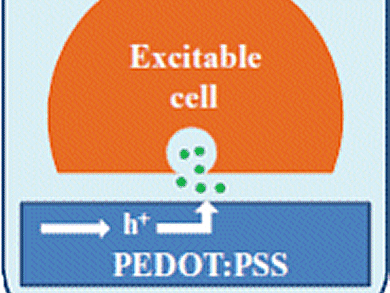The release of transmitter molecules from neurons and neuroendocrine cells and the subsequent transduction of biochemical signal into electrical excitation, play a key role in how neurons communicate. George Malliaras and colleagues, Ecole Nationale Supérieure des Mines de Saint Etienne, France, have developed an organic device that performs this transduction on the level of a single cell. The team used the conducting polymer poly(3,4-ethylenedioxythiophene) doped with poly(styrene sulfonate) (PEDOT:PSS) to form a microelectrode surface where transmitter molecules were detected electrochemically with high enough resolution to record individual exocytosis events.
The detection of transmitter release from living cells is a new example of how conducting polymers can interface with the nervous system. This could allow new bioelectronic devices to be developed, such as an artificial synapse that controls the release of neurotransmitters.

Image: Wiley-VCH
- Detection of Transmitter Release from Single Living Cells Using Conducting Polymer Microelectrodes
S. Y. Yang, B. N. Kim, A. A. Zakhidov, P. G. Taylor, J.-K. Lee, C. K. Ober, M. Lindau, G. G. Malliaras,
Adv. Mater. 2011.
DOI: 10.1002/adma.201100035



